Engineless
Sailing
(Posted
10/28/2016)
(See bottom of
this page for post-voyage updates)
We'll
be sailing without an engine, using 12 foot long sweeps as our primary auxiliary power.
More
than any other aspect of our somewhat unconventional approach to voyaging, sailing engineless seems to evoke a sense of heresy among other sailors. I'd like to be able to trot out some rational defense of sailing engineless, but I don't have one. My first boat had an engine and I swore it would be the last one that did. I've kept my word on that, owning 3 other small voyaging boats since, all engineless. It's not that there haven't been times when an engine would have been welcome. Rather, it has more to do with my mindset, with what I go sailing for. I prefer being in a situation in which I have to be more aware of my surroundings, of weather and currents, in closer partnership with the boat, and above all, more patient. Not having an engine to rely on gives me that. Once the anchor is weighed, I simply have no choice.
I also feel more alive on the water without an engine. It's analogous to camping in grizzly bear country without a gun. I've done enough of it to know that when I'm not the top predator, I'm more aware of my surroundings, of the smells, the sounds, the vegetation, the terrain. In short, I feel more alive. There's no shortcut to getting there. I just have to put myself in the situation and deal with it as competently as possible.
Here's
another analogy: Among my friends my prodigious appetite for sweets is renowned. I'm the sort of person who will eat whatever sweets are in the cupboard. To describe it as a lack of willpower misses the point. If it's there, I will eat it. Willpower doesn't even factor into the decision. Where willpower becomes relevant is in the decision not to have sweets in the house in the first place. That I can and will do. Sure, I miss them from time to time, but overall, I get used to not having them and it's certainly better for my health. Sailing engineless is somewhat similar for me. Equipped with an engine, I'd start it about as soon as the wind died and in the bargain would lose what I prefer about not having that choice. Not having the option is a decision I can make.
(Pearl) I知 new to engineless sailing, but I view it like I do some of the other technologies that are considered essential to being civilized.
I'll digress for a moment with an analogy. Most Americans wouldn稚 consider being without a flush toilet. We use a composting toilet at home and will use a bucket system on the boat. For many reasons we wouldn稚 consider a flush toilet in either setting. Since David is skilled in many practical aspects of life, he usually knows more about plumbing than anyone else around (despite not having plumbing in our own home), so he gets called upon to fix plumbing problems for our friends. And you can guess who gets called upon to help him with these projects. Every time I work on a clogged toilet I give thanks for our non-cloggable system. When I read of sailors living with an on-board tank of sewage (and of issues with these), I wonder why.
I suspect I値l feel similarly about sailing without an engine. I am delighted not to be sharing our limited space with a noisy, smelly, potentially leaky beast, and the food that it needs to run. Sure, there may be times that we値l have to do things differently than if we had an engine, and maybe it値l seem like more work at those times. And probably we値l be frustrated many times at slow progress when winds are light to non-existent. But in the grand scheme of things, I知 guessing that we値l actually SAVE time and effort, or at least frustration. Cruising stories seem to abound with engine problems. Although David is skilled with all things mechanical, he is not a happy camper when dealing with greasy engine repairs. I値l gladly accept the times we'll need to exercise patience in exchange for having a happier sailing partner.

Auxiliary power with two 12 foot sweeps.
| 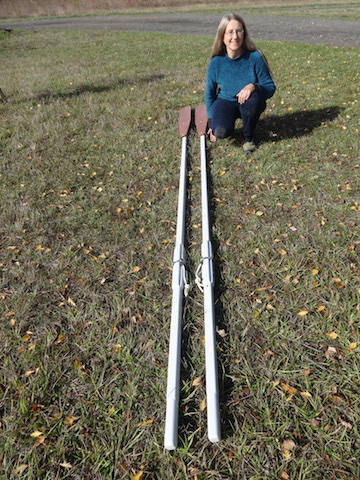
12 foot sweeps. Looms are built from 1-1/2" x 1-1/2" Douglas fir boards. Blades are
made from 3/4" x 5" redwood boards. Looms and blades are coated with epoxy.
|

Sweep blade is screwed to loom using 1/4" x 2" stainless steel screws
with fender washers under screw heads.
| 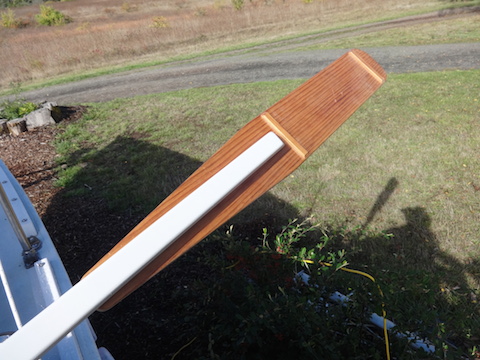
Back side of blade is reinforced with wood slats to help prevent blade from splitting.
|
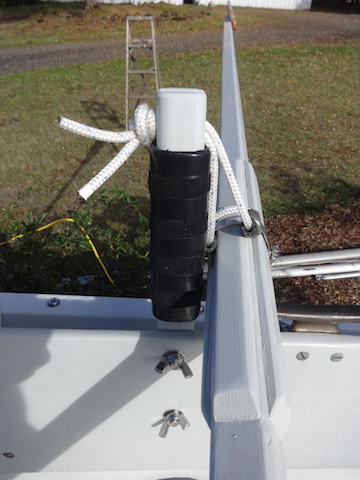
Our oarlocks are a variation on the thole pin. They're made from a 1-1/2" x 1-1/2" board
bolted to the cockpit coaming with wingnuts for easy removal.
At the top is a groove that takes the oar rope. The method gives a
quiet, smooth action in use.
| 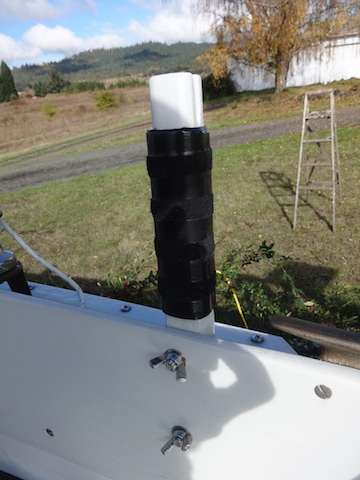
The oarlock was wrapped in several layers of 4 ounce fiberglass cloth and epoxy for extra strength.
Oarlock is wrapped with dense foam for padding. Leather would
be more durable and if we come across some and have time, we may replace the foam.
|

Oar rope is secured to oar with a hose clamp. A piece of rubber hose protects
the rope from chafing on the hose clamp.
| 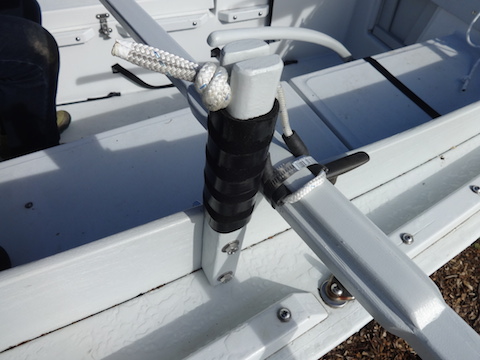
Top view of oarlock and oar rope.
|
Post-voyage comments (updated 10-14-2017):
We found it interesting that what set us apart, far more
than our diminutive size was the fact that we were engineless. We often
watched with envy as boats motored into an anchorage, looked over the various
available spots and then selected one. While we probably also looked at
ease as we rowed in, inwardly we always felt a certain level of tension as we
kept a weather eye out for the next squall, not to mention coral heads and other
boats. The sailing scene has changed considerably since I last did it
extensively back in the early 1980's. There are many more boats crowding
the anchorages these days and anchoring with oars has become quite a bit more
challenging than it once was.
The above observations notwithstanding, the oars and
oarlocks worked well and there's nothing about them we'd change next time.
What we would be inclined to do differently would be to take along a small
outboard, say 2-1/2 hp strictly for getting into and out of anchorages.
Especially appealing would be one of the electric outboards, which are now
becoming more readily available. At
sea we would have no use for it, but it would take much of the tension out of
maneuvering in anchorages. With a small outboard we might also have been
inclined to explore a few more of the Tuamotu atolls. Without it,
negotiating the passes was a risk we were unwilling to take.
Back
to Sailing home page
Back
to omick.net home page







